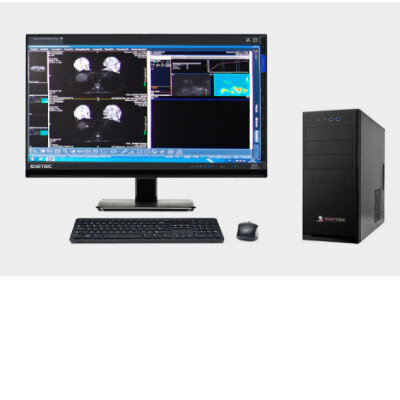Portable MRI Machine with Automatic Motion Correction Enables Brain Scans Inside Ambulance
|
By MedImaging International staff writers Posted on 06 Jan 2022 |

A new portable MRI system that is likely to be used in space could also be used to take brain scans inside stroke patients inside their home or the back of the ambulance.
Doctors at the Medical University of South Carolina’s Comprehensive Stroke Center (Charleston, SC, USA) used a portable MRI developed by Hyperfine (Guilford, CT, USA) to test whether an MRI scan could be successfully completed in the back of a moving ambulance.
Minutes matter for stroke patients when the brain is being deprived of oxygen. Reducing the time before treatment begins isn’t simply a matter of reducing the number of stroke deaths but also about reducing the severity of disabilities for those who survive. For every 15-minute reduction in ‘door-to-needle time’ there is a significant improvement in patient outcomes, including reduction in disabilities and reduction in mortality. Doctors at MUSC Health constantly work with their community hospital colleagues on initiatives to cut down the steps that need to happen between the time a stroke patient is wheeled through the ambulance bay until treatment can begin – for example, by developing a TeleEMS program so emergency medical technicians can consult with stroke specialists while inside a patient’s home or the back of the ambulance.
However, some things still need to happen at the hospital before treatment can begin, though, like scans of the brain to confirm a stroke and determine what type it is. If it were possible to do an MRI scan in the ambulance, then not only would doctors be better prepared when the ambulance arrived, but the stroke specialists could determine whether the patient could be treated at a community hospital or would need to go directly to a specialized stroke center.
Hyperfine’s portable MRI is designed to be wheeled around a hospital to conduct brain scans at the bedside for patients who cannot be moved. It weighs 1,400 pounds and is roughly the size of an office printer turned on its side, making it smaller than the average MRI machine. The portable MRI features automatic motion correction and as the MUSC team drove along in the ambulance, it could see that as the ambulance bounced over the roads the scanner actually moved. The team wanted to demonstrate whether the portable MRI would still be able to function and acquire diagnostic images in a moving vehicle and was amazed to see that the scanner itself was able to sense the motion and correct that in real time, enabling crystal clear images.
Some areas have started deploying mobile stroke units, which are ambulances with CT scanners, a critical care nurse and a CT technician in addition to a paramedic. While these units have been shown to improve patients’ outcomes by decreasing the time to treatment, they are expensive at USD 600,000 to USD 1 million per unit. A portable MRI machine would be a fraction of that cost and would bring the advantages of MRI scanning. MRI, unlike CT, does not use radiation, thus eliminating radiation exposure to the patient or the first responders.
Additionally, an MRI is also a more accurate diagnostic tool for stroke. It can show smaller blockages, and, in the case of strokes caused by blood clots, it would allow doctors to determine whether a patient needed the clot-busting drug tPA, which can be administered at community hospitals, or a thrombectomy, a surgical procedure to remove the clot. The current triage system calls for patients to first go to a tPA-capable center and receive tPA. Although tPA works well for small blood clots, it is much less likely to work on large clots.
“So, if you can imagine, if a patient has a large clot in the brain, they go to the tPA center and get tPA and then transfer here. By the time they get here, there is a very good chance that those patients will no longer be eligible for thrombectomy because there's already so much damage,” said Sami Al Kasab, M.D., associate medical director of the MUSC Health Teleneuroscience Program.
Related Links:
Medical University of South Carolina
Hyperfine
Latest MRI News
- PET/MRI Improves Diagnostic Accuracy for Prostate Cancer Patients
- Next Generation MR-Guided Focused Ultrasound Ushers In Future of Incisionless Neurosurgery
- Two-Part MRI Scan Detects Prostate Cancer More Quickly without Compromising Diagnostic Quality
- World’s Most Powerful MRI Machine Images Living Brain with Unrivaled Clarity
- New Whole-Body Imaging Technology Makes It Possible to View Inflammation on MRI Scan
- Combining Prostate MRI with Blood Test Can Avoid Unnecessary Prostate Biopsies
- New Treatment Combines MRI and Ultrasound to Control Prostate Cancer without Serious Side Effects
- MRI Improves Diagnosis and Treatment of Prostate Cancer
- Combined PET-MRI Scan Improves Treatment for Early Breast Cancer Patients
- 4D MRI Could Improve Clinical Assessment of Heart Blood Flow Abnormalities
- MRI-Guided Focused Ultrasound Therapy Shows Promise in Treating Prostate Cancer
- AI-Based MRI Tool Outperforms Current Brain Tumor Diagnosis Methods
- DW-MRI Lights up Small Ovarian Lesions like Light Bulbs
- Abbreviated Breast MRI Effective for High-Risk Screening without Compromising Diagnostic Accuracy
- New MRI Method Detects Alzheimer’s Earlier in People without Clinical Signs
- MRI Monitoring Reduces Mortality in Women at High Risk of BRCA1 Breast Cancer
Channels
Radiography
view channel
Novel Breast Imaging System Proves As Effective As Mammography
Breast cancer remains the most frequently diagnosed cancer among women. It is projected that one in eight women will be diagnosed with breast cancer during her lifetime, and one in 42 women who turn 50... Read more
AI Assistance Improves Breast-Cancer Screening by Reducing False Positives
Radiologists typically detect one case of cancer for every 200 mammograms reviewed. However, these evaluations often result in false positives, leading to unnecessary patient recalls for additional testing,... Read moreUltrasound
view channel
Deep Learning Advances Super-Resolution Ultrasound Imaging
Ultrasound localization microscopy (ULM) is an advanced imaging technique that offers high-resolution visualization of microvascular structures. It employs microbubbles, FDA-approved contrast agents, injected... Read more
Novel Ultrasound-Launched Targeted Nanoparticle Eliminates Biofilm and Bacterial Infection
Biofilms, formed by bacteria aggregating into dense communities for protection against harsh environmental conditions, are a significant contributor to various infectious diseases. Biofilms frequently... Read moreNuclear Medicine
view channel
New SPECT/CT Technique Could Change Imaging Practices and Increase Patient Access
The development of lead-212 (212Pb)-PSMA–based targeted alpha therapy (TAT) is garnering significant interest in treating patients with metastatic castration-resistant prostate cancer. The imaging of 212Pb,... Read moreNew Radiotheranostic System Detects and Treats Ovarian Cancer Noninvasively
Ovarian cancer is the most lethal gynecological cancer, with less than a 30% five-year survival rate for those diagnosed in late stages. Despite surgery and platinum-based chemotherapy being the standard... Read more
AI System Automatically and Reliably Detects Cardiac Amyloidosis Using Scintigraphy Imaging
Cardiac amyloidosis, a condition characterized by the buildup of abnormal protein deposits (amyloids) in the heart muscle, severely affects heart function and can lead to heart failure or death without... Read moreGeneral/Advanced Imaging
view channel
New AI Method Captures Uncertainty in Medical Images
In the field of biomedicine, segmentation is the process of annotating pixels from an important structure in medical images, such as organs or cells. Artificial Intelligence (AI) models are utilized to... Read more.jpg)
CT Coronary Angiography Reduces Need for Invasive Tests to Diagnose Coronary Artery Disease
Coronary artery disease (CAD), one of the leading causes of death worldwide, involves the narrowing of coronary arteries due to atherosclerosis, resulting in insufficient blood flow to the heart muscle.... Read more
Novel Blood Test Could Reduce Need for PET Imaging of Patients with Alzheimer’s
Alzheimer's disease (AD), a condition marked by cognitive decline and the presence of beta-amyloid (Aβ) plaques and neurofibrillary tangles in the brain, poses diagnostic challenges. Amyloid positron emission... Read more.jpg)
CT-Based Deep Learning Algorithm Accurately Differentiates Benign From Malignant Vertebral Fractures
The rise in the aging population is expected to result in a corresponding increase in the prevalence of vertebral fractures which can cause back pain or neurologic compromise, leading to impaired function... Read moreImaging IT
view channel
New Google Cloud Medical Imaging Suite Makes Imaging Healthcare Data More Accessible
Medical imaging is a critical tool used to diagnose patients, and there are billions of medical images scanned globally each year. Imaging data accounts for about 90% of all healthcare data1 and, until... Read more
Global AI in Medical Diagnostics Market to Be Driven by Demand for Image Recognition in Radiology
The global artificial intelligence (AI) in medical diagnostics market is expanding with early disease detection being one of its key applications and image recognition becoming a compelling consumer proposition... Read moreIndustry News
view channel
Bayer and Google Partner on New AI Product for Radiologists
Medical imaging data comprises around 90% of all healthcare data, and it is a highly complex and rich clinical data modality and serves as a vital tool for diagnosing patients. Each year, billions of medical... Read more




















